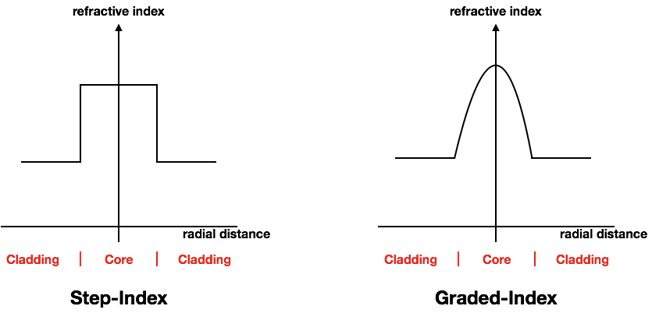Graded-Index Fiber, also known as G.651.1 under International Telecommunication Union (ITU) standards, is a type of fiber whose refractive index decreases gradually as the radial distance (distance to the core center) increases. In comparison, what we commonly have seen is G.652.D fiber which has a step-index refractive index profile. This article will compare graded-index multimode fiber with traditional step-index fiber, as well as its advantages when dealing with modal dispersion, a common signal distortion error.
The graph below shows the different refractive index profiles of the fiber core and cladding.

Figure 1. Left: Step-Index refraction index of core and cladding. Right: Graded-Index of core and cladding
The refractive index of the core is higher than that of the cladding to achieve total internal reflection, trapping the light inside the core. With a step-index core, the light only reflects at the core-cladding interface as seen below:

Figure 2.Light travels in the step-index fiber core
However, when the refractive index drops gradually in a graded-index core, the light also slightly bends and follows a curved path as seen below:

Figure 3. Light travels in the graded-index core
The advantages of the curved light path will be discussed in detail later in the article, but essentially the ray following a longer path will travel faster than the ray following a shorter path in a graded-index core. That is because the speed of light inside the fiber is inversely proportional to the refractive index.
To explain the advantages of graded-index fiber, let’s first discuss modal dispersion because it is seen in traditional step-index multimode fibers.
Modal Dispersion is induced in multimode applications where different light modes exit the fiber asynchronously even though they enter the fiber simultaneously. Again, this happens because the velocities of all light modes are the same since the refractive index is uniform inside the core. The following graph shows Mode A and Mode B entering the fiber at the same time:

Figure 4. Mode A and Mode B enter the fiber core at the same time but different incident angles
Apparently, Mode B follows a shorter path than mode A, so B will arrive ahead of mode A as both lights have the same velocity. Assuming the signal is an ideal pulse entering the fiber, after traveling p km, the pulse will spread temporally:

Figure 5. Mode B is ahead of A when exiting the fiber because it traveled a shorter distance.
However, when more than one pulse is sent into the fiber at a fixed time interval, the resulting signal becomes indistinguishable since Mode B from the second pulse (blue) might arrive before the Mode A from the first pulse (black):

Figure 6. Two pulses are sent into the core with some time apart; two signals are overlapped when exiting.
This phenomenon is known as modal dispersion. Modal dispersion limits the bandwidth of the signal to tens of MHz.km, meaning when the fiber is 1km long, the signal bandwidth cannot exceed tens of MHz without confusion.
The modal dispersion can be significantly reduced with graded-index fiber. Similarly, two modes enter the fiber, Mode A with a larger incident angle:

Figure 7. Mode A and Mode B enter the fiber core simultaneously, with A at a larger incident angle.
Mode A follows a longer path than Mode B but arrives almost at the same time as B. As I have explained earlier, although B travels longer, it also travels faster than A thanks to a lower refractive index near the core-cladding interface. Comparing to traditional multimode fiber, graded-index multimode can accept higher bandwidth without signal confusion.
Graded-index multimode fiber is being widely manufactured and used nowadays and is replacing step-index ones rapidly. Some large fiber manufacturers have created graded-index brand such as ClearCurve®fiber from Corning®. In fact, step-index multimode fiber is less common than graded-index, and most manufacturers’ default option for multimode fiber is graded-index.
M2 Optics offers premium multimode fiber from manufacturers such as Corning® and OFS®, and we customize each module per customer requests.
-----
Since 2001, M2 Optics has been an established manufacturer and innovator of professional optical fiber platforms for fiber network simulation, latency / optical time delay, training, and demonstration applications. Our customer base includes many of the world's most recognized communications service providers, equipment manufacturers, data centers, web service providers, financial institutions, research institutions, and government agencies.






